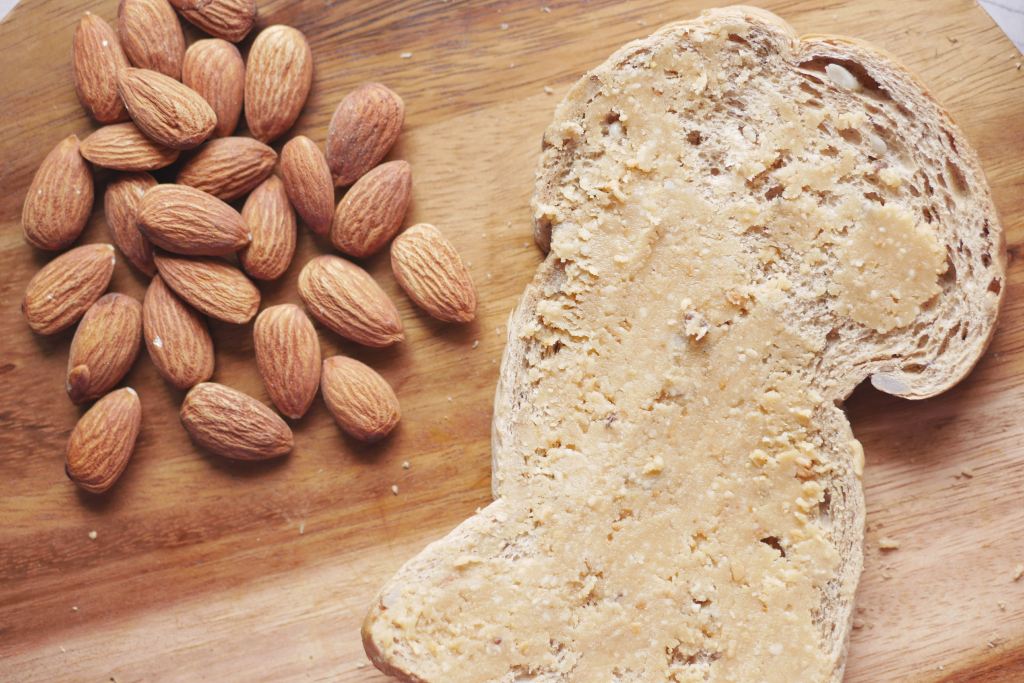Why Choose Plant-Based Butters Over Dairy?
When comparing dairy butter to plant-based alternatives, the nutritional differences stand out. Dairy butter is high in saturated fats (52.1 g per 100 g) and cholesterol, both of which can contribute to cardiovascular concerns when consumed in excess. While it does offer vitamin A and a rich, creamy texture, its drawbacks often outweigh these benefits, particularly for consumers focused on heart health or lactose-free diets.
Plant-based butters, on the other hand, bring a wealth of advantages. They are cholesterol-free and rich in unsaturated fats, which are known to support heart health by improving cholesterol levels. Nut and seed butters like almond butter also provide fiber, protein, and essential vitamins and minerals, such as magnesium, potassium, and vitamin E. These nutrients contribute to a wide range of health benefits, from muscle function to antioxidant protection.
In addition to their nutritional value, plant-based butters offer greater versatility. They can meet the needs of consumers looking for non-dairy solutions while also appealing to those seeking allergen-friendly, vegan, or clean-label products. This makes them a flexible and valuable ingredient for modern food formulations, providing both health benefits and functionality in a variety of applications.
Popular Healthy Butter Alternatives to Consider
Nut and seed butters are not only rich in nutrients but also offer diverse flavor profiles, making them versatile ingredients in food product development. Here’s a detailed look at some popular plant-based healthy butter alternatives:
Almond Butter
Nutritional Profile and Considerations
Almond butter stands out for its high fiber, calcium, potassium, and magnesium content. It also contains vitamin E, which supports skin and immune health, and unsaturated fats beneficial for heart health. Almond butter has a relatively balanced macronutrient profile, with no significant downsides. However, it is higher in calories compared to some other butters, which may be a consideration for calorie-conscious formulations. This section, I caution as it plays with the misconception that due to their high calories, one can gain weight; however, studies have shown that eating almonds helps lose weight. I am sending a nutrition benefit and nutrition research infographic that can be helpful.
Flavor Profile and Applications
Almond butter has a slightly sweet, nutty flavor that works well in both sweet and savory products. It is versatile in applications like baked goods, smoothies, sauces, and spreads, and is especially popular in non-dairy and clean-label formulations.
Cashew Butter
Nutritional Profile and Considerations
Cashew butter is rich in magnesium and zinc, essential for metabolic and immune functions. It provides moderate protein and unsaturated fats. However, it is lower in fiber compared to almond butter and has slightly higher levels of saturated fat, which may not align with heart-healthy claims. Cashew butter is also less nutrient-dense in terms of calcium and potassium, limiting its functional benefits in certain applications.
Flavor Profile and Applications
Cashew butter offers a mild, buttery flavor with a natural sweetness, making it ideal for creamy sauces, frostings, and desserts. Its neutral profile allows it to blend easily in both sweet and savory recipes.
Peanut Butter
Nutritional Profile and Considerations
Peanut butter is high in protein and niacin, which supports energy metabolism. It is a cost-effective source of unsaturated fats and provides vitamin E, a potent antioxidant. However, peanut butter is high in calories and contains significant amounts of omega-6 fatty acids, which, when consumed excessively, may contribute to inflammation. It also poses allergen risks, limiting its use in inclusive formulations.
Flavor Profile and Applications
Peanut butter has a bold, roasted flavor that pairs well with sweet applications like spreads and desserts or savory ones like satay sauce. However, its strong flavor can overshadow more delicate ingredients.
Sunflower Butter
Nutritional Profile and Considerations
Sunflower butter is a good source of vitamin E and magnesium, supporting cardiovascular health and anti-inflammatory benefits. Its primary advantage is its allergen-free status, making it suitable for nut-free products. On the downside, sunflower butter is relatively low in protein and may contain added sweeteners or stabilizers, reducing its overall nutritional quality in some formulations.
Flavor Profile and Applications
Sunflower butter has an earthy, nutty flavor with a subtle sweetness. It is ideal for allergy-friendly snacks, spreads, and baked goods. Its unique taste complements fruit pairings and adds depth to confections and smoothies.
Sesame Butter (Tahini)
Nutritional Profile and Considerations
Tahini is rich in calcium, magnesium, and antioxidants like sesamin and sesamol, which support bone health and cellular protection. However, it is lower in protein compared to other butters and has a higher calorie content. Its bitter undertone can also limit its use in sweeter applications.
Flavor Profile and Applications
Tahini has a bold, savory flavor with slightly bitter notes, making it a staple in Middle Eastern cuisine. It works well in hummus, dressings, and sauces, adding depth to savory recipes.
Hazelnut Butter
Nutritional Profile and Considerations
Hazelnut butter is rich in monounsaturated fats and vitamin E, promoting heart health and antioxidant defense. However, it is lower in protein compared to other nut butters and often higher in fat, which may not suit low-fat formulations. It is also less versatile due to its naturally strong and sweet flavor.
Flavor Profile and Applications
Hazelnut butter offers a sweet, roasted flavor that pairs exceptionally well with chocolate. It is widely used in confectionery products, spreads, and desserts, but its rich taste limits its suitability for savory dishes.
Nutritional Comparison Table
Here’s a summary of the nutritional content per tablespoon of various nut and seed butters:
| Butter Type |
Calories |
Protein (g) |
Fat (g) |
Calcium (mg) |
Zinc (mg) |
| Almond Butter |
101 |
2.4 |
9.5 |
43 |
0.5 |
| Cashew Butter |
93 |
2.8 |
8.0 |
7 |
0.8 |
| Peanut Butter |
94 |
3.8 |
8.0 |
7 |
0.4 |
| Sunflower Butter |
80 |
3.0 |
7.0 |
– |
– |
| Sesame Butter |
89 |
2.6 |
8.0 |
64 |
0.7 |
| Hazelnut Butter |
94 |
2.0 |
9.5 |
– |
– |
Source: Plant Based Butters. Journal of Food Science and Technology (Gorrepati et al., 2015)
Almond butter stands out for its balanced profile, combining fiber, calcium, and healthy fats, making it an ideal choice for those seeking a nutrient-dense butter option.
How to Choose the Right Healthy Butter Alternative for Your Product
Selecting the best butter alternative requires a clear understanding of your product goals. Here’s a step-by-step guide:
- Define Your Objectives: Are you creating a high-protein snack, a clean-label spread, or a nut-free option? Identifying your target attributes is essential.
- Consider Flavor Profiles: Match the butter’s flavor with your product. Almond butter pairs well with sweet and savory, while tahini enhances Mediterranean-inspired dishes.
- Evaluate Nutritional Value: Choose options that align with health trends, such as high-protein or low-fat profiles.
- Assess Functional Needs: Think about texture, emulsification, and shelf life. For example, stabilizers may be needed for long-lasting spreads.
- Account for Costs: Consider ingredient sourcing and production expenses while balancing quality and affordability.
This process ensures the selection of the most effective butter alternative for your product’s unique requirements.
Key Considerations in Developing Plant-Based Butters
For those developing or refining plant-based butter formulations, technical precision is vital. Consider these factors to optimize your production:
- Roasting and Grinding Techniques
Proper roasting enhances flavor and preserves nutrients. For almond butter, medium roasting balances taste and nutrient retention, while grinding impacts texture. Uniform particle size ensures a smooth and appealing mouthfeel.
- Stabilizers and Emulsifiers
To prevent oil separation and maintain consistency, stabilizers like lecithin or mono-diglycerides are commonly used. These ingredients improve product stability, especially in commercial applications where shelf life is a key consideration.
- Shelf-Life Optimization
Storage and processing conditions directly affect shelf life. Using airtight packaging and storing at cool temperatures minimizes oxidation, preserving the butter’s flavor and nutritional integrity.
- Partnering with Trusted Suppliers
Working with reliable suppliers ensures access to high-quality ingredients and technical expertise. A trusted supplier like Harris Woolf Almonds provides sustainably sourced, premium almond butter tailored to your product specifications. Their commitment to quality ensures consistency and reliability in every batch.
Transform Your Recipes with Harris Woolf Almonds’ Custom Almond Butter
If you’re looking for a healthy butter alternative to elevate your products, almond butter is a game-changer. Packed with nutrition and incredibly versatile, almond butter can bring depth and quality to everything from non-dairy beverages to baked goods and nutrition bars. At Harris Woolf Almonds, we craft premium almond butter using 100% pure almonds—no additives, no compromises. It’s a clean, natural ingredient you can trust.
Whether you need a light, medium, or extra-light roast, our almond butter is tailored to your needs. We’re here to support you, from small-batch orders to full-scale production runs. With our expertise and reliable supply chain, you can confidently scale your innovations while meeting market demand.
Let’s Collaborate
Reach out today and discover how Harris Woolf Almonds can help you create standout products. Our team is ready to customize almond butter solutions designed just for you.













